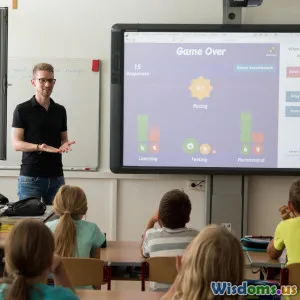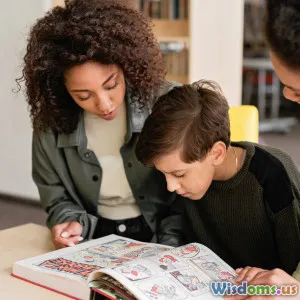
The Future of Education: Collaborative or Independent?
7 min read Explore how education is evolving: will future learning be collaborative, independent, or a blend of both? (0 Reviews)
The Future of Education: Collaborative or Independent?
Education stands at a pivotal crossroads. As technologies like AI, VR, and adaptive learning platforms revolutionize how we learn, a compelling question arises: will the future of education favor collaborative learning environments, independent study, or a strategic blend of both? This complex inquiry invites reflection on how educational strategies mold not only knowledge acquisition but critical thinking, creativity, and lifelong learning competencies.
Introduction: A New Era of Learning
Education has always been about transmitting knowledge, but its methods continuously evolve. Traditional classrooms thrived on group activities and discussions, promoting collaboration. Yet, the rise of digital tools has also empowered learners to study independently at their own pace. With the ongoing shift to e-learning and hybrid models accelerated by global events, educators and policymakers are reexamining which approach best prepares learners for a rapidly changing world.
What might the future hold? Will education lean towards enhanced collaboration, capitalizing on social constructs, or will it privilege independent learners capable of self-regulation? Let’s delve into the trends, advantages, challenges, and real-world examples that frame this debate.
The Case for Collaborative Learning
Advantages of Collaboration in Education
Collaborative learning engages students actively with peers, fostering skills beyond academic content, including communication, teamwork, and emotional intelligence. Research highlights that learners who interact within groups tend to retain knowledge better and develop nuanced understanding through discourse and debate.
For instance, the National Education Association emphasizes that cooperative learning can "improve critical thinking capabilities and deepen content mastery" (NEA, 2021).
Educational innovations like project-based learning and peer instruction rely fundamentally on social interaction. The rise of online collaboration tools such as Zoom, Slack, and Google Workspace has further embedded this approach into digital classrooms, making remote group work seamless and effective.
Real-World Examples
-
PBL at High-Tech High in San Diego: Students collaborate on interdisciplinary projects, often engaging with community partners, demonstrating real-world uses of collaborative learning.
-
Massive Open Online Courses (MOOCs): Platforms like Coursera and edX include discussion forums and peer assessments, enabling large-scale collaboration among global learners.
Challenges
Despite benefits, collaborative learning isn't without hurdles. Integrating diverse learners requires thoughtful facilitation, while unequal participation or group conflicts may complicate outcomes. Technology barriers can also hamper interaction, particularly in underserved communities.
The Rise of Independent Learning
Benefits of Autonomous Study
Independent learning empowers students to tailor education to their needs, pace, and interests. This autonomy fosters self-discipline, motivation, and metacognitive skills critical for lifelong learning.
Adaptive learning platforms like Knewton harness AI to customize content delivery based on a learner's progress, enabling highly individualized study paths. A 2022 report by HolonIQ found that personalized learning solutions reduced dropout rates by up to 25% in several pilot programs.
Case in Point
-
Khan Academy: Offers extensive self-paced modules with instant feedback and mastery tracking, supporting independent learners worldwide.
-
Duolingo: Provides language learning through gamification, encouraging practice at the learner’s convenience.
Challenges
However, not all learners thrive independently. Lack of motivation, limited social interaction, and isolation can undermine engagement and emotional well-being. The digital divide also poses access challenges, limiting benefits for some populations.
Synthesizing Both Approaches: Blended Learning as the Future
The most compelling vision for the future blends collaboration and independence, leveraging technology and pedagogy to create adaptive, interactive, and student-centered environments.
What Does Blended Learning Look Like?
Blended learning models combine face-to-face instruction with online independent activities. This hybrid approach maximizes flexibility, allowing collaboration when it enriches understanding and autonomy when individual effort is paramount.
Supporting Evidence
-
A 2020 study by the Clayton Christensen Institute found that blended learning boosts performance by combining self-paced mastery with collaborative problem-solving.
-
Schools implementing the "flipped classroom" model have reported higher student engagement and academic gains by moving lectures online for independent study and reserving in-class time for peer discussion and projects.
Future Innovations
AI-driven platforms might customize the blend dynamically, discerning when a student benefits most from collaboration versus independent focus. VR environments could simulate collaborative labs or independent exploration exercises.
Educational institutions like Minerva Schools integrate global collaboration through digital platforms while encouraging students' independent research and reflection.
Conclusion: A Balanced Path Forward
The future of education is unlikely to be exclusively collaborative or independent. Instead, the trend points to a nuanced, data-informed balance that respects individual learner differences and leverages the distinct advantages of both approaches.
To prepare for an uncertain future, educators must cultivate environments rooted in flexibility—embracing new technologies and pedagogies that adapt to learners’ evolving needs. Policymakers should support equitable technological access to ensure all students can benefit from this dynamic educational landscape.
Ultimately, learning is a deeply personal journey, but it flourishes best when supported by a vibrant community and a strong foundation of self-directed inquiry. Harnessing the symmetry between collaborative and independent learning will empower the next generation to navigate complex challenges with confidence, creativity, and compassion.
References:
- National Education Association (NEA). (2021). Benefits of Cooperative Learning.
- HolonIQ. (2022). Personalized Learning Report.
- Clayton Christensen Institute. (2020). Blended Learning Efficacy.
- Minerva Schools. (n.d.). Innovative Learning Models.
This article is brought to you as part of the ongoing conversation on education and smart learning futures, striving to inform and inspire learners, educators, and stakeholders worldwide.
Rate the Post
User Reviews
Popular Posts




















